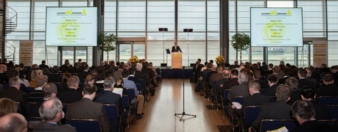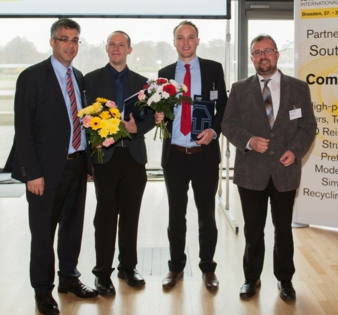04/02/2015 — auf Deutsch lesen
8th ADITC: High-tech from South Korea
“The extraordinary does not happen on ordinary paths.” With this quotation from Goethe, Professor Chokri Cherif, Director of the Institute of Textile Machinery and High Performance Material Technology (ITM) at Dresden Technical University (TU Dresden), welcomed the 700+ participants at this year’s Aachen-Dresden International Textile Conference (ADITC). As a whole, this international, technology-orientated conference, which focuses on a different subject every year, is increasing its coverage of inter-disciplinary peripheral topics in order to maximise the development potential of textile materials for a wide range of applications and to demonstrate the beneficial synergies for manufacturers, suppliers and users across an array of disciplines.
Hans Müller-Steinhagen, Rector of TU Dresden, emphasised in his welcome speech that TU Dresden was developing in giant steps, that it ranked highly in international terms and was already one of the top German universities. And for Franz-Jürgen Kümpers, Chairman of the Board of Directors at the Forschungskuratorium Textil, the German umbrella organisation for textile research based in Berlin, the Aachen-Dresden Textile Conference is “the Mecca for science, industry and the new student generation”. His exciting suggestion was that the present duo of Aachen and Dresden should be expanded to a trio by including Stuttgart as a venue for the International Textile Conference – first East and West, now the South. As he said, “Nobody could miss such an International Textile Conference any more!”
In his plenary presentation, Florian Meyer of Audi AG, Ingolstadt, highlighted lightweight construction in the automotive field as a key factor in reversing the ‘weight spiral’. He outlined the optimal use of different properties available from various materials and chassis construction methods in the multi-material mix. Bionic design and construction principles in complex fibre-based architectural structures were the subject of the presentation by Jan Knippers, of the Institute of Building Structures and Structural Design at the University of Stuttgart.
This world-renowned expert on membrane construction techniques explained the process chain, from researching biological examples, through computer-based modelling and statistical analysis, to the automated generation of what are known as ‘winding paths’. In his plenary presentation, Vladimir Dyakanov of the Würzburg-based Bavarian Centre for Applied Energy Research (ZAE Bayern), introduced energy-efficient solutions in textile architecture, taking as his example the Energy Efficiency Centre (EEC), a research and demonstration building in Würzburg. Its textile roof is an integral factor in the energy concept and consists of translucent PTFE-coated fibre-glass fabrics and transparent ETFE film with a solar protective print.
Current developments and high-tech applications from the highly industrialised country of South Korea, which had been selected as a partner nation, were the subject of a number of presentations and posters. In addition, delegates were given a comprehensive overview of future developments in the Korean textile industry. Alongside over 100 poster presentations, another highlight was the awards ceremony on behalf of the TU Dresden ITM Friends’ and Patrons’ Association. Two graduates of the Institute of Textile Machinery and High Performance Material Technology at TU Dresden received awards for exceptional theses.
[Gisela Cozdzik/Iris Schlomski]
The 8th Aachen-Dresden International Textile Conference (ADITC), held on 27 and 28 November 2014 at the International Congress Centre in Dresden, attracted over 705 participants. One-fifth of them came from abroad; some 45% were from industry and from various associations.
The textile research institutes in the regions surrounding Aachen and Dresden have been running the ADITC jointly since 2007. It alternates between Aachen and Dresden and is well established in the world of textiles.





